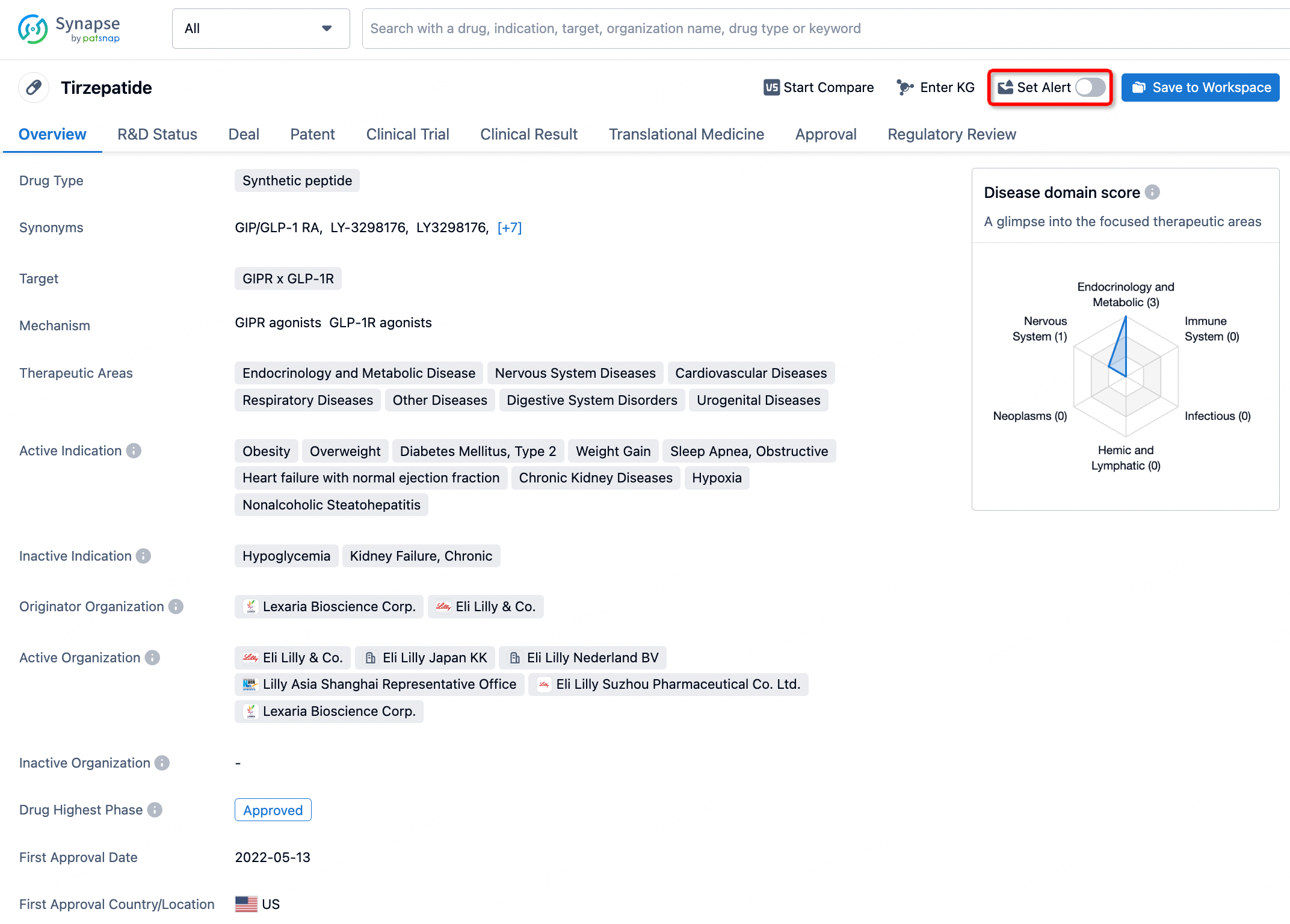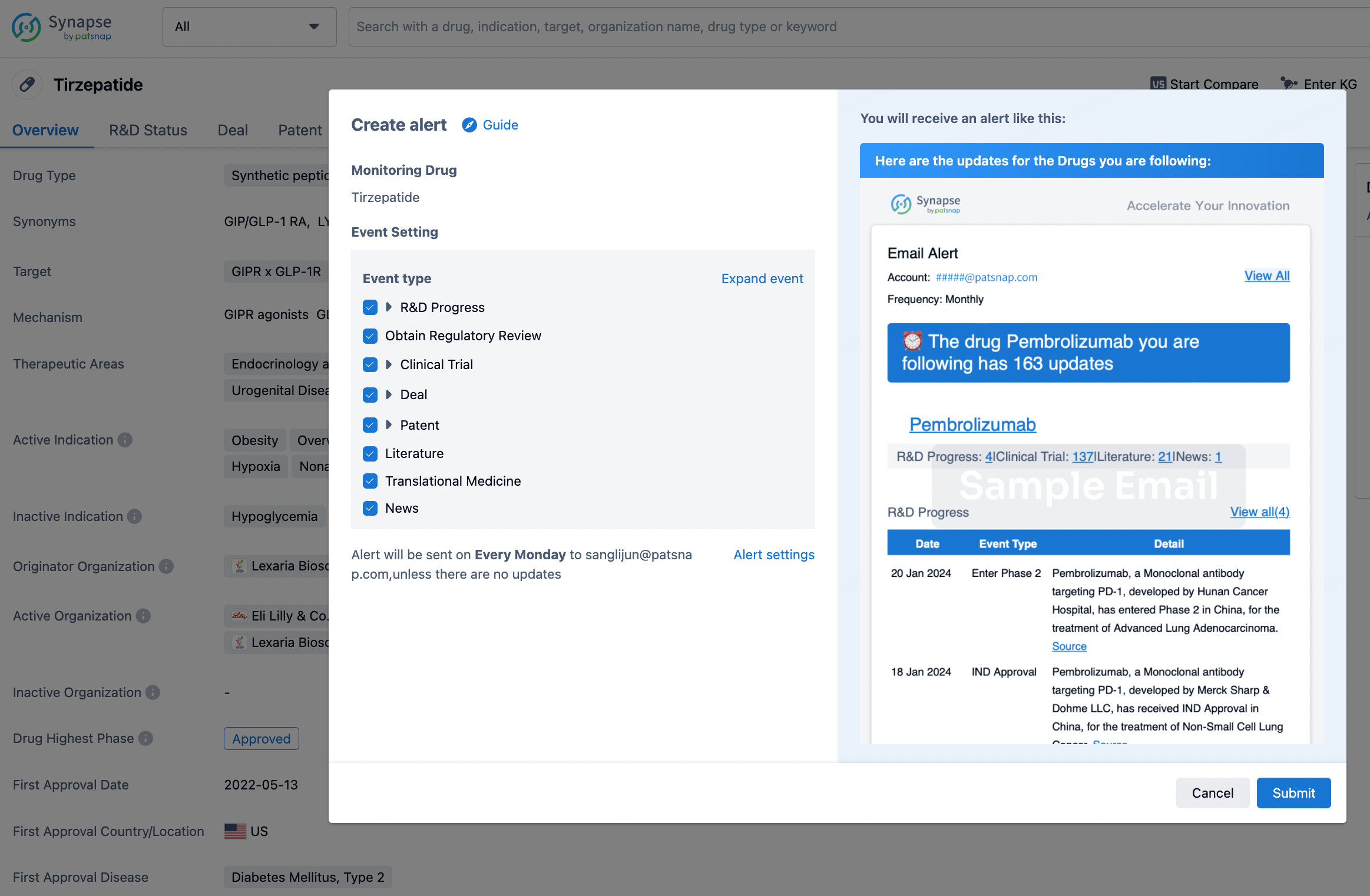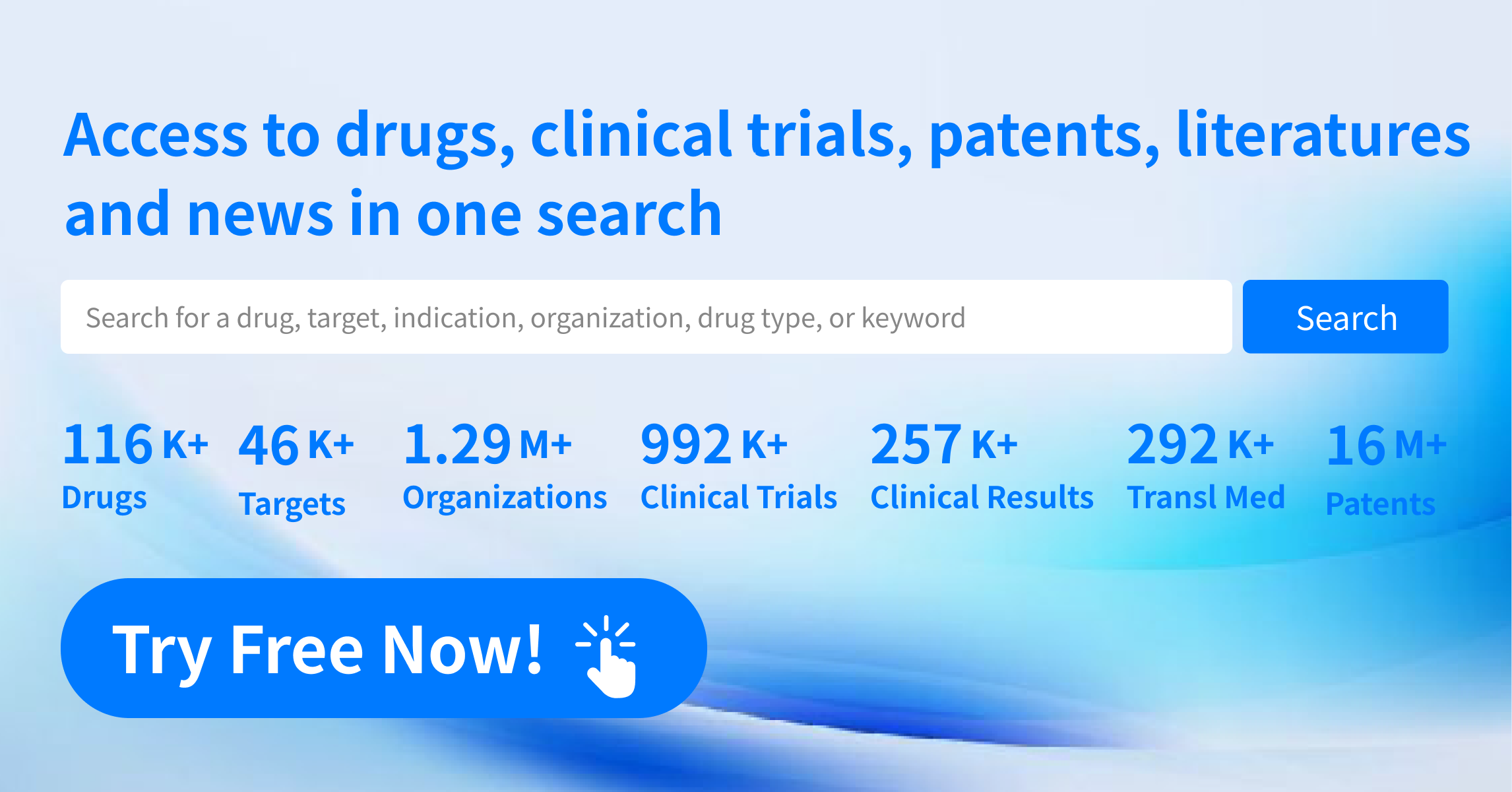Request Demo
What is Dicycloplatin used for?
14 June 2024
Introduction to Dicycloplatin:
Dicycloplatin is a chemotherapeutic agent that has garnered significant interest in the field of oncology. As one of the newer platinum-based drugs, it shares some similarities with well-known agents like cisplatin and carboplatin, but it brings unique advantages to the table. Dicycloplatin is known by its research code name L-OHP and is currently not marketed under any commercial brand names. It targets rapidly dividing cancer cells by forming DNA adducts that interfere with cell division and induce apoptosis. Research institutions globally, including prominent cancer research centers and universities, have been investigating the efficacy and safety of Dicycloplatin in various forms of cancer, such as lung, ovarian, and colorectal cancers. The drug is still in clinical trial phases, with several studies showing promising results in terms of both efficacy and reduced toxicity compared to other platinum-based chemotherapeutics.
Dicycloplatin Mechanism of Action:
The mechanism of action of Dicycloplatin involves its interaction with DNA in cancer cells. Upon administration, Dicycloplatin enters the cancer cells and undergoes intracellular activation. It then forms highly reactive platinum complexes that bind to the purine bases on the DNA strand, primarily at the N7 position of guanine and adenine. This binding results in the formation of intrastrand and interstrand DNA crosslinks. These crosslinks disrupt the DNA double helix structure, thereby inhibiting DNA replication and transcription.
The formation of these DNA adducts triggers a cascade of cellular responses, including the activation of various DNA damage response pathways. One of the critical pathways involves the activation of the p53 protein, which plays a central role in regulating the cell cycle and inducing apoptosis. The inability of the cancer cells to repair the extensive DNA damage leads to cell cycle arrest at the G2/M phase and eventually to programmed cell death (apoptosis). This targeted approach helps to eradicate cancer cells while sparing most of the normal cells, which typically have a lower rate of division and hence, are less susceptible to the effects of Dicycloplatin.
How to Use Dicycloplatin:
Dicycloplatin is administered intravenously, usually in a clinical setting under the supervision of an oncologist. The drug is delivered as an aqueous solution directly into the bloodstream, allowing for rapid distribution throughout the body. The specific dosage and administration schedule of Dicycloplatin can vary depending on factors such as the type of cancer being treated, the stage of the cancer, patient weight, age, renal function, and overall health status. Typically, it is given in cycles, with each cycle consisting of a single infusion followed by a recovery period to allow the patient's body to recover from the cytotoxic effects of the drug.
The onset of action for Dicycloplatin occurs relatively quickly after administration. The drug begins to interact with the DNA within hours, and the therapeutic effects can generally be observed within a few days to a week after the first dose. Patients undergoing treatment with Dicycloplatin are closely monitored for any adverse reactions, and dose adjustments may be made based on the patient's response and tolerance to the treatment.
What is Dicycloplatin Side Effects:
Like all chemotherapeutic agents, Dicycloplatin is associated with a range of potential side effects. The severity and type of side effects can vary from patient to patient. Common side effects include nausea, vomiting, fatigue, and mild to moderate myelosuppression, which is a decrease in the production of blood cells. This can lead to anemia, increased risk of infections, and bleeding problems.
Other notable side effects include nephrotoxicity (kidney damage), neurotoxicity (nerve damage), and ototoxicity (hearing loss). Patients receiving Dicycloplatin should have their kidney function monitored regularly, as impaired renal function can increase the risk of severe toxicity. Neurological side effects can manifest as peripheral neuropathy, characterized by tingling, numbness, or pain in the hands and feet. Hearing loss, particularly high-frequency hearing loss, is another possible side effect that warrants monitoring.
Contraindications for the use of Dicycloplatin include patients with known hypersensitivity to platinum compounds, severe renal impairment, and those with preexisting severe neurotoxicity. Pregnant or breastfeeding women should avoid using Dicycloplatin due to potential harm to the fetus or infant.
What Other Drugs Will Affect Dicycloplatin:
Dicycloplatin can interact with other medications, which may affect its efficacy or increase the risk of adverse effects. Drugs that are known to cause nephrotoxicity, such as aminoglycoside antibiotics (e.g., gentamicin) and nonsteroidal anti-inflammatory drugs (NSAIDs), should be used with caution in patients receiving Dicycloplatin due to the increased risk of kidney damage.
Other chemotherapeutic agents and radiation therapy can also interact with Dicycloplatin. Combination therapies are often employed in cancer treatment, but careful consideration must be given to the cumulative toxicities. For instance, combining Dicycloplatin with other platinum-based drugs or agents that cause myelosuppression can exacerbate hematologic toxicity, requiring dose adjustments or supportive care measures.
Antiemetic drugs, such as ondansetron or metoclopramide, are frequently used to manage the nausea and vomiting associated with Dicycloplatin administration. While these drugs are beneficial, their interaction with Dicycloplatin is generally well-tolerated and does not typically pose significant risks.
Patients should inform their healthcare provider of all medications they are taking, including prescription drugs, over-the-counter medications, and herbal supplements, to ensure that potential interactions are managed appropriately. Regular monitoring and communication with the healthcare team are essential to optimize treatment outcomes and minimize risks.
In conclusion, Dicycloplatin represents a promising advancement in the field of chemotherapy, offering a new option for patients with various types of cancer. Ongoing research and clinical trials will continue to elucidate its full potential, safety profile, and optimal use in combination with other therapies. As with any cancer treatment, careful consideration of the benefits and risks, along with personalized patient care, is crucial for achieving the best possible outcomes.
Dicycloplatin is a chemotherapeutic agent that has garnered significant interest in the field of oncology. As one of the newer platinum-based drugs, it shares some similarities with well-known agents like cisplatin and carboplatin, but it brings unique advantages to the table. Dicycloplatin is known by its research code name L-OHP and is currently not marketed under any commercial brand names. It targets rapidly dividing cancer cells by forming DNA adducts that interfere with cell division and induce apoptosis. Research institutions globally, including prominent cancer research centers and universities, have been investigating the efficacy and safety of Dicycloplatin in various forms of cancer, such as lung, ovarian, and colorectal cancers. The drug is still in clinical trial phases, with several studies showing promising results in terms of both efficacy and reduced toxicity compared to other platinum-based chemotherapeutics.
Dicycloplatin Mechanism of Action:
The mechanism of action of Dicycloplatin involves its interaction with DNA in cancer cells. Upon administration, Dicycloplatin enters the cancer cells and undergoes intracellular activation. It then forms highly reactive platinum complexes that bind to the purine bases on the DNA strand, primarily at the N7 position of guanine and adenine. This binding results in the formation of intrastrand and interstrand DNA crosslinks. These crosslinks disrupt the DNA double helix structure, thereby inhibiting DNA replication and transcription.
The formation of these DNA adducts triggers a cascade of cellular responses, including the activation of various DNA damage response pathways. One of the critical pathways involves the activation of the p53 protein, which plays a central role in regulating the cell cycle and inducing apoptosis. The inability of the cancer cells to repair the extensive DNA damage leads to cell cycle arrest at the G2/M phase and eventually to programmed cell death (apoptosis). This targeted approach helps to eradicate cancer cells while sparing most of the normal cells, which typically have a lower rate of division and hence, are less susceptible to the effects of Dicycloplatin.
How to Use Dicycloplatin:
Dicycloplatin is administered intravenously, usually in a clinical setting under the supervision of an oncologist. The drug is delivered as an aqueous solution directly into the bloodstream, allowing for rapid distribution throughout the body. The specific dosage and administration schedule of Dicycloplatin can vary depending on factors such as the type of cancer being treated, the stage of the cancer, patient weight, age, renal function, and overall health status. Typically, it is given in cycles, with each cycle consisting of a single infusion followed by a recovery period to allow the patient's body to recover from the cytotoxic effects of the drug.
The onset of action for Dicycloplatin occurs relatively quickly after administration. The drug begins to interact with the DNA within hours, and the therapeutic effects can generally be observed within a few days to a week after the first dose. Patients undergoing treatment with Dicycloplatin are closely monitored for any adverse reactions, and dose adjustments may be made based on the patient's response and tolerance to the treatment.
What is Dicycloplatin Side Effects:
Like all chemotherapeutic agents, Dicycloplatin is associated with a range of potential side effects. The severity and type of side effects can vary from patient to patient. Common side effects include nausea, vomiting, fatigue, and mild to moderate myelosuppression, which is a decrease in the production of blood cells. This can lead to anemia, increased risk of infections, and bleeding problems.
Other notable side effects include nephrotoxicity (kidney damage), neurotoxicity (nerve damage), and ototoxicity (hearing loss). Patients receiving Dicycloplatin should have their kidney function monitored regularly, as impaired renal function can increase the risk of severe toxicity. Neurological side effects can manifest as peripheral neuropathy, characterized by tingling, numbness, or pain in the hands and feet. Hearing loss, particularly high-frequency hearing loss, is another possible side effect that warrants monitoring.
Contraindications for the use of Dicycloplatin include patients with known hypersensitivity to platinum compounds, severe renal impairment, and those with preexisting severe neurotoxicity. Pregnant or breastfeeding women should avoid using Dicycloplatin due to potential harm to the fetus or infant.
What Other Drugs Will Affect Dicycloplatin:
Dicycloplatin can interact with other medications, which may affect its efficacy or increase the risk of adverse effects. Drugs that are known to cause nephrotoxicity, such as aminoglycoside antibiotics (e.g., gentamicin) and nonsteroidal anti-inflammatory drugs (NSAIDs), should be used with caution in patients receiving Dicycloplatin due to the increased risk of kidney damage.
Other chemotherapeutic agents and radiation therapy can also interact with Dicycloplatin. Combination therapies are often employed in cancer treatment, but careful consideration must be given to the cumulative toxicities. For instance, combining Dicycloplatin with other platinum-based drugs or agents that cause myelosuppression can exacerbate hematologic toxicity, requiring dose adjustments or supportive care measures.
Antiemetic drugs, such as ondansetron or metoclopramide, are frequently used to manage the nausea and vomiting associated with Dicycloplatin administration. While these drugs are beneficial, their interaction with Dicycloplatin is generally well-tolerated and does not typically pose significant risks.
Patients should inform their healthcare provider of all medications they are taking, including prescription drugs, over-the-counter medications, and herbal supplements, to ensure that potential interactions are managed appropriately. Regular monitoring and communication with the healthcare team are essential to optimize treatment outcomes and minimize risks.
In conclusion, Dicycloplatin represents a promising advancement in the field of chemotherapy, offering a new option for patients with various types of cancer. Ongoing research and clinical trials will continue to elucidate its full potential, safety profile, and optimal use in combination with other therapies. As with any cancer treatment, careful consideration of the benefits and risks, along with personalized patient care, is crucial for achieving the best possible outcomes.
How to obtain the latest development progress of all drugs?
In the Synapse database, you can stay updated on the latest research and development advances of all drugs. This service is accessible anytime and anywhere, with updates available daily or weekly. Use the "Set Alert" function to stay informed. Click on the image below to embark on a brand new journey of drug discovery!
AI Agents Built for Biopharma Breakthroughs
Accelerate discovery. Empower decisions. Transform outcomes.
Get started for free today!
Accelerate Strategic R&D decision making with Synapse, PatSnap’s AI-powered Connected Innovation Intelligence Platform Built for Life Sciences Professionals.
Start your data trial now!
Synapse data is also accessible to external entities via APIs or data packages. Empower better decisions with the latest in pharmaceutical intelligence.


